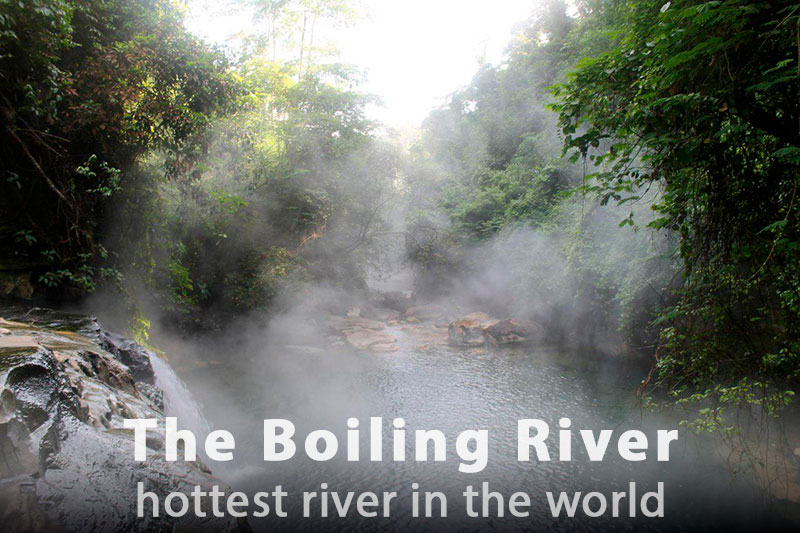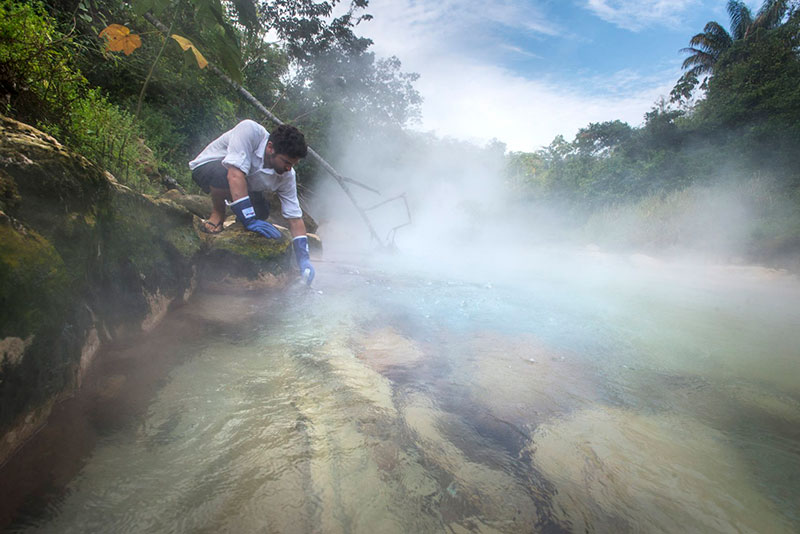The boiling river is a genuinely remarkable natural phenomenon that scientists do not have a full explanation of so far. And it is really hard to understand why some of its parts heat up to a boiling point. Especially given no nearby volcanoes that could affect its temperature. We will tell more about this special river based on verified scientific information.

It is located in Peru, in the region of Puerto Inca. It is not very long, only 6.4 kilometers from the source to the mouth. It travels through the Amazon River, and together they flow into the Atlantic Ocean.
It's close but still does not come to boiling. Some of its parts (the temperature throughout the river is very uneven) heat up to +95–97 degrees Celsius—sufficient to boil you alive if you fall onto it.
Local relief is quite complex and thus features significant elevation changes. This resulted in a 6-meter-high waterfall. It is for sure, if not the most, but certainly one of the hottest waterfalls globally.
Surely, the most obvious explanation for this is volcanic activity, except that the nearest volcano is 700 kilometers away—clearly too far to have at least some impact on the river.
This river flows in the Amazon rainforest of the state of Peru. Local communities (mainly the Ashaninka Indians that belong to the Arawak linguistic family) call it Shanay-Timpishka, which literally means "boiled by the heat of the Sun." It can't boast of a great length—it's only 6.4 km long, while the temperature ranges from +40 to +97 degrees Celsius along the river! For you to compare: a comfortable temperature for a bath, which most humans are fine with, is about +40 degrees Celsius. And +97°C is more than enough for any creature caught in the river to boil up in a mere few seconds.
The first records of the river date back to the beginning of the 16th century. They were created by the conquistadors who came to South America, led by Francisco Pizarro. When he heard from the locals about the city built of gold (the legendary El Dorado), they set off on a journey to the dense jungle, looking for this place and a guarantee of their future life of ease.
But only a few returned. They also told about the dangers lurking in waiting for adventurers in these rainforests. And it's not only Indians with their poisoned arrows. It's as if nature itself had turned against the explorers: snakes eat humans whole, giant trees cover the sky up, and a terrifying river kills everyone who dares to step into it. Seems like Shanay-Timpishka is this very river described above.
Geophysicist Andrés Ruzo has heard legends about the boiling river since childhood. However, he never took them as anything but fairy tales. But over time, he got interested in where these legends come from. So Andrés decided to find the boiling river, or at least its prototype. And he did it! His aunt, who had already been to these dangerous places, guided him.
Together they reached the river, which was 25 meters wide and 6 meters deep. Thus, he found out that a fairy tale is not always fiction. 
It's a fallacy to assume that the water is boiling all along the river. And it’s easy to explain why—geothermal water sources are not something uncommon in our world. Water at the river source is not very hot—about +28 degrees Celsius, which is the norm for hot Peru.
But if you go downstream and take some measurements, you can notice abrupt temperature jumps. Water suddenly heats up to almost +70°C just one kilometer away from the source and drops below +50 in a few hundred meters. The second sharp jump takes place about 800 meters after the first one. Here the water reaches its peak temperature of +95–97 degrees Celcius! Then again, there is a series of slight ups and downs, but the temperature never exceeds this level.
Water heating is typically explained by the presence of active volcanoes in the nearby area. But there is no volcanic activity near Shanay-Timpishka! The closest volcano is no less than 700 kilometers away. Apparently, it cannot heat water up at such a distance.
Researcher Andrés Ruzo swears to crack the mystery of the boiling river. He believes that water flows down from the Andes located nearby and goes underground through faults in the earth's crust. There it interacts with magma and becomes very hot. And then the water is fed to the surface through the faults—right under the legendary boiling river— and heats its separate stretches up.
There's a problem, though—this theory does not explain a sharp drop in temperature right after heating. Anyway, it highlights the existence of many other secrets of nature we haven't revealed so far! So, scientists should be on their toes—there are still many amazing things to explain.
References: Links and sources